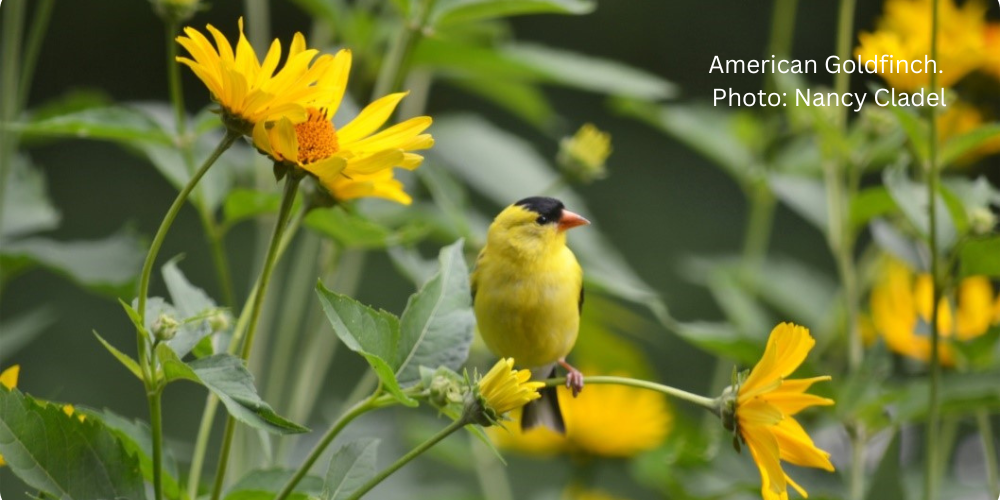
Birds are important members of a functioning ecosystem. They control pests, pollinate plants, disperse seeds, and some are even members of the environment’s clean-up crew. They also provide endless hours of entertainment to the whole bird-watching cohort. To attract these feathered friends to take up residence on your property, they require food, water, shelter, and cover for survival. Some of these necessities can be provided with man-made materials, like feeders and birdbaths; however, providing them with natural resources can be more efficient, cost effective, and sustainable. Below, grouped by habitat layer, are some avian favorites to consider for inclusion in your home garden, public landscape, or land preserve.
CANOPY TREES are the tallest layer of a typical habitat found in nature, growing over 100 feet. This layer provides cover for the site below with its dense ceiling of leaves and tree branches:
- Oak (Quercus) – If you have a lawn large enough to accommodate this 50- to 80-foot tall by 40- to 80-foot wide keystone tree, go for it. Red, black, and white oaks provide so many services to so many insects and animals. They are larval hosts to over 500 caterpillar species, which create food for young birds, and their acorns are a secondary food supply. Oaks also provide critical cover and nest sites.
- Birch (Betula ) – The aromatic Allegheny birch (40 to 70 feet tall by 60 to 75 feet wide) as well as its narrower and very showy relative, the river birch, play a key role in feeding songbirds with their spring catkins; and they support over 400 species of caterpillars, which add to the food web.

UNDERSTORY TREES make up the next habitat layer. They grow from 15 to 49 feet and provide food and shelter for much of the wildlife in the area:
- Black cherry and wild plum (Prunus) – Talk about a smorgasbord of fruits for animals and humans alike. Plus, these medium-sized trees offer nectar and pollen to bumblebees in spring and are host plants for tiger swallowtail, viceroy, red-spotted purple, and coral hairstreak butterflies.
- Serviceberry (Amelanchier laevis) – This smaller tree is the first to produce fruit here in Pennsylvania, also known as Juneberries, which are sure to bring in all of the local songbirds. It also provides special value to native bees with its April blooms, and over 100 caterpillar species rely on it as their host.
SHRUBS can grow up to 33 feet and differ from trees with their shorter height and multiple stems. Birds prefer the forked branches for cover and nest sites. Here’s where you might find brown thrashers, especially in tangled thickets and hedgerows. The two suggestions below require more than one plant for optimal fruit set:
- Blueberry (Vaccinium angustifolium or corymbosum) – Both the low- and high-bush blueberry shrubs are habitat superstars that like acidic soil. They host nearly 300 caterpillar species, their blooms are pollinated mostly by bumblebees and hummingbirds, and their scrumptious fruits are foraged by robins, bluebirds, catbirds, mockingbirds, and others.
- Viburnum – Viburnums come in all sizes and one is sure to fit in your landscape. After flowering, like the blueberry shrubs above, these become fruit factories for fauna, plus they are the larval host for spring and summer azure butterflies.
PERENNIALS are in the herbaceous habitat layer and die to the ground every winter. The foliage then decomposes and becomes an essential part in the nutrient cycling of the site. Their blooms provide nectar and pollen sources, which then give way to seeds. If you leave the stems and stalks standing, cardinals, finches, and other wintering birds will feed on them throughout the cold months. The cycle will repeat itself in the spring when the plants emerge again.
- Forest sunflower (Helianthus decapetalus) – In a partial-shade area, this sunflower provides the most amount of habitat services for the space it takes up. Many native bees, butterflies, and flies will visit its summer blooms; and its end-of-season seed heads feed birds and other mammals. It also is a larval host for silvery checkerspot and painted lady butterflies.
- Green-headed coneflower (Rudbeckia laciniata) – For a sunnier spot, this long-blooming perennial can go head to head with the forest sunflower above in supporting bees, butterflies, and wintering birds.
Resources:
The Living Landscape by Rick Darke and Doug Tallamy